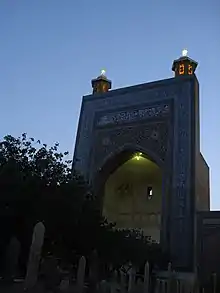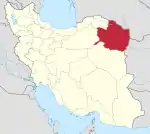Torbat-e Jam
Torbat-e Jam (Persian: تربت جام, romanized: Torbat-e Jām; also known as Torbat-e Sheykh Jām, Torbat-e Jawm, and Turbat-i-Shaikh Jam)[3] is a city in, and the capital of, the Central District of Torbat-e Jam County, Razavi Khorasan province, Iran, and also serves as capital of the county. It is one of the ancient cities of Greater Khorasan.
Torbat-e Jam
Persian: تربت جام | |
|---|---|
City | |
 Torbat-e Jam | |
| Coordinates: 35°14′35″N 60°37′30″E[1] | |
| Country | Iran |
| Province | Razavi Khorasan |
| County | Torbat-e Jam |
| District | Central |
| Population (2016)[2] | |
| • Total | 100,449 |
| Time zone | UTC+3:30 (IRST) |
| Torbat-e Jam at GEOnet Names Server | |
At the 2006 census, its population was 83,558 in 19,111 households.[4] The following census in 2011 counted 94,758 people in 23,970 households.[5] The latest census in 2016 showed a population of 100,449 people in 27,156 households.[2]
Torbat-e Jam is an ancient city with a Sunni-majority population.[6] It is about 160 kilometres (99 mi) southwest of Mashhad, about 60 kilometres (37 mi) north of Taybad, and about 40 kilometres (25 mi) west of the Afghanistan border. There are many ancient places there, like the mazar (tomb) of Sheikh Ahmad Jami and Prince Qasem-e Anvar. The county includes many villages, such as Bezd, Mahmoodabad, Nilshahr.
Music
Torbat-e-Jam music has a long history in Iranian culture. The dotar is the most important and common instrument among the people of Torbat-e-Jam, which is played with great skill. The music of this land originates from the heart of rituals and customs that are thousands of years old. Poetry reading, salawat reading, travel music, mothers' lullabies, educational music, prayers are some of the branches of vocal music in Torbat-e Jam. Reading couplets is also very common in Torbat-e Jam music, which includes romantic, emotional, mystical and other couplets.
Local Dance
There are many local dances in the culture of the Torbat-e Jām people, but four types are more common: Hetan or Hatem dance: means the edges of a mountain or lion grove and a kind of mystical hearing.[7] In which people make a circle and knock their feet to the ground while circling. Gradually, they accelerate their dance, clapping their arms together and making the circle smaller.[8]
Hapelbazi: This dance is performed in such a way that one person performs movements inside the circle and the others follow him.
Stick play: This dance may be an example of fencing in ancient Iran, in which two people spin in a circle and hold two sticks in their hands, and the first person throws his sticks to the sticks of the second person, and whoever breaks his stick, goes out of the circle.
Historical places
Sheikh Ahmad-e Jami Mausoleum Complex,[9] Khatoon Bridge, Noor Mosque, Bazd Mountain, Leopard Mountain, Abe Bazd, Jahangir Abad Hill, Sarab Hill, Shore Qaleh Hill, Sadrabad Hill, Golden Hill, Qoshe Toot Hill, Garmab Hill, Glarcheh Hill, Ganjabad Hill, Khajeh Hesam, Estai Castle, Zurabad Castle, Faizabad Castle, Gabri Castle, Gosh Laghar Castle, Qanqar, Kariz Divan, Glar Sarem and Khajeh Azizullah Mosque are the scenic and historical places of this region.
Handicrafts
The handicrafts of Torbat-e-Jam city are: carpet weaving, canvas weaving, towel weaving, Weaving large black nomadic tents, handkerchief weaving and night tent Hapelbazi: This dance is performed in such a way that one person performs movements inside the circle and the others follow him.making, traditional clothe weaving [10] and also making pottery, It is one of the handicrafts of Torbat-e-Jam . Carpet weaving industry has been popular in this city since ancient times and has an export aspect. Carpets are usually woven at home and there are many carpet weaving workshops in the city. The carpets are marketed with Mashhad carpet design in red beads and brown colors.
Agriculture
Torbat-e Jam is the center of agricultural production in eastern Iran, so that it has the largest population of people working in this field among other cities in Khorasan Razavi province. This city ranks first in the production of products such as melons, barley saffron, wheat and many summer crops in Khorasan province. Today, saffron and pistachio cultivation is increasing in different areas of Torbat-e Jam, so that this area has become one of the poles. Mangosteen or hazelnut is another agricultural product that is native to this region and is world famous.[11]
Industry
In the past, there were only a few factories with limited production in the field of food next to the sugar and flour factory in Torbat-e Jam industry, but in recent years, with the expansion of industrial towns and the establishment of parent industries such as cement factory and silica processing,[12] the industrial landscape in this city is clear. It seams. However, due to the establishment of these industries in tourist areas and proximity to residential areas, their presence has been associated with environmental hazards.
Monuments
Historic monuments in Torbat-e Jam, Khorasan province, have been under serious threat of destruction. The Ahmad-i Jam shrine complex has now been renovated with private and public funds from Iran's Cultural Heritage Organization.[13]
The head of Torbat-e Jam Cultural Heritage and Tourism Department put the credit allocated for restoration of historic sites in the city at 550 million rials in the current year (started 21 March). He noted that from the total amount, 500 million rials was spent on Robat-e Jam historic site and the rest on Sheikh Ahmad Jami mausoleum—a complex comprising 10 buildings, ISNA reported. Taj-Mohammadi complained that given the number of monuments and the huge workload, the earmarked budget is insufficient. The other major historic sites of this northeastern city which face destruction are Robat-e Sangan, Khajeh Azizollah Mosque, Shah Qassem Anvar Mausoleum, Noor Mosque and Abouzar Bozjani Mausoleum, he warned. Torbat-e Jam is the birth and burial place of the renowned 11th century mystic Sheikh Ahmad Jami. The city is in fact named after the great mystic. Located on the mountains 163 kilometers east of Mashhad, Torbat-e Jam has a desert climate with wild pistachio forests and vast pastures. Torbat-e Jam and its neighbouring areas have a rich and beautiful local and mystical music.
Higher Education
Currently, two government higher education centers are located in Torbat-e Jam, Torbat-e-Jam Medical School and Torbat-e-Jam Higher Education Complex.[14] Also Islamic Azad Universities and Payame Noor and Applied Sciences, Vahdat Institute of Higher Education.[15]

Notable people
- Sheikh Ahmad Jami (1048–1142) – Sufi mystic
- Pur-Baha Jami – Iranian poet and satirist
- Mohsen Namjoo (b. 1976) – alternative/indie singer-songwriter
- Abu al-Wafa' Buzjani (10 June 940 – 15 July 998) – a Persian mathematician and astronomer who worked in Baghdad
- Jami (7 November 1414 – 9 November 1492) – writer, mystic and one of the most prominent Sufi poets of the 15th century
References
- OpenStreetMap contributors (10 May 2023). "Torbat-e Jam, Torbat-e Jam County" (Map). OpenStreetMap. Retrieved 10 May 2023.
- "Census of the Islamic Republic of Iran, 1395 (2016)". AMAR (in Persian). The Statistical Center of Iran. p. 09. Archived from the original (Excel) on 2 April 2022. Retrieved 19 December 2022.
- Torbat-e Jam can be found at GEOnet Names Server, at this link, by opening the Advanced Search box, entering "-3087659" in the "Unique Feature Id" form, and clicking on "Search Database".
- "Census of the Islamic Republic of Iran, 1385 (2006)". AMAR (in Persian). The Statistical Center of Iran. p. 09. Archived from the original (Excel) on 20 September 2011. Retrieved 25 September 2022.
- "Census of the Islamic Republic of Iran, 1390 (2011)" (Excel). Iran Data Portal (in Persian). The Statistical Center of Iran. p. 09. Retrieved 19 December 2022.
- "The Iranian Government is more Pragmatic in dealing with Sunnis than its Sectarian image Implies". Informed Comment. 26 April 2021. Retrieved 27 April 2021.
- "Iran Newspaper". 17 February 2009. Archived from the original on 17 February 2009. Retrieved 3 January 2022.
- "آداب و رسوم اهالی تربت جام". Aftabir.com (in Persian). Retrieved 3 January 2022.
- "Sheikh Ahmad-e Jami Mausoleum Complex, Torbat-e Jam". Tripadvisor. Retrieved 31 December 2021.
- "Traditional cloth weaving Torbat-e-Jam/ Combination of cotton and polyester". Tanva. Retrieved 29 December 2021.
- "مجتمع آموزش عالی کشاورزی و دامپروری تربت جام - معرفی شهرستان>توانمندیهای بخش کشاورزی". 18 April 2018. Archived from the original on 18 April 2018. Retrieved 6 December 2021.
- "Torbat-e Jam cement plant project to begin soon". Tehran Times. 25 September 2006. Retrieved 10 December 2021.
- Mahendrarajah, Shivan (2021). The Sufi saint of Jam : history, religion and politics of a Sunni shrine in Shi'i Iran. New York. ISBN 978-1-108-83969-3. OCLC 1195815515.
{{cite book}}: CS1 maint: location missing publisher (link) - "Torbat Jam Faculty of Medical Sciences".
- "Islamic Azad University, Torbat Jam Branch".
